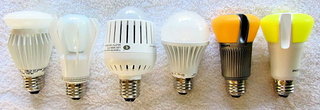LED light bulb

LED bulbs consist of light emitting diodes designed and manufactured as lighting fixtures (see Figure 1). These devices use a semiconductor to turn electricity into light. As opposed to incandescent light bulbs, LEDs do not emit light by using a filament that glows when an electric current is applied, which makes LEDs much more energy-efficient than traditional light bulbs since there is much less energy lost as heat.
Disadvantages
The most obvious disadvantage of LED lighting is that the immediate cost of purchasing LED bulbs is significantly higher than that of incandescent light bulbs. Although the price of LEDs has decreased over time, they are still more expensive to purchase than the traditional options.[2] Another disadvantage has to do with the Color Rendering Index (CRI) of LEDs. The CRI is a value on a scale from 1 to 100 that measures how accurately light sources render color realistically. Incandescent bulbs have a CRI value above 95.[3] Although LEDs can achieve CRI values in the 90s, such bulbs tend to be particularly expensive. However, most LED bulbs readily achieve CRI values in the 80s, and higher CRI values are generally not required except in places like art galleries.[4] It is also important to note that there is doubt about the accuracy of the Color Rendering Index in evaluating LED bulbs.[5]
Advantages
The primary advantages of LED lighting is its superior lifespan and efficiency. LEDs use at least 75% less energy and last 25 times longer than incandescent lighting. LEDs also stay much cooler than CFL light bulbs and incandescent bulbs. Additionally, they are much more durable than incandescent bulbs as they are made with epoxy lenses rather than glass.[6] Finally, LED light bulbs are significantly cheaper than incandescent bulbs when the energy costs for running the bulb are factored in, since the higher upfront cost of purchasing LED lighting is offset by its incredible energy efficiency.[7]
For Further Reading
For further information please see the related pages below:
References
- ↑ From https://commons.wikimedia.org/wiki/File:LED_bulbs_2012.jpg
- ↑ Concerns about LED Light Bulbs [Online]. Available:http://science.howstuffworks.com/environmental/green-tech/sustainable/led-light-bulb3.htm
- ↑ What is color rendering index? [Online]. Available:http://www.lrc.rpi.edu/programs/nlpip/lightinganswers/lightsources/whatisColorRenderingIndex.asp
- ↑ What is Color Rendering Index (CRI)? [Online]. Available:http://www.topbulb.com/color-rendering-index
- ↑ LED Basics [Online]. Available:http://energy.gov/eere/ssl/led-basics
- ↑ LED Lighting [Online]. Available:http://energy.gov/energysaver/articles/led-lighting
- ↑ Everything you need to know about LED light bulbs [Online]. Available:http://www.popularmechanics.com/home/how-to/a10104/everything-you-need-to-know-about-led-light-bulbs-16542040/

